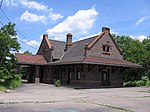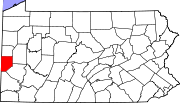Aliquippa, Pennsylvania
This May 2010 needs additional citations for verification. (May 2010) |
Aliquippa, Pennsylvania | |
|---|---|
 Downtown Aliquippa, Pennsylvania | |
 Location in Beaver County | |
| Country | United States |
| State | Pennsylvania |
| County | Beaver |
| Settled | 1793 |
| Incorporated | 1894 |
| 1928 (borough) | |
| 1987 (city) | |
| Government | |
| • Type | Council/Manager |
| Area | |
| • Total | 4.5 sq mi (11.6 km2) |
| • Land | 4.1 sq mi (10.6 km2) |
| • Water | 0.4 sq mi (1.0 km2) |
| Elevation | 850 ft (260 m) |
| Population (2000) | |
| • Total | 11,734 |
| • Density | 2,867.7/sq mi (1,107.7/km2) |
| Time zone | UTC-5 (Eastern (EST)) |
| • Summer (DST) | UTC-4 (EDT) |
| Zip code | 15001 |
Aliquippa is a city in Beaver County, Pennsylvania, United States, within the Pittsburgh metropolitan area. The population was 11,734 at the 2000 census. Formerly a borough, it was formally named a city in 1987 by the Aliquippa Council.
History

Aliquippa was founded by the merger of three towns: Aliquippa (now called West Aliquippa), Woodlawn, and New Sheffield [1]. There is no evidence connecting the Seneca Queen Alliquippa with the location of the borough. This was one of several Indian names selected arbitrarily by the Pittsburgh and Lake Erie Railroad in 1878 for stations along the route [2]. Aliquippa is best known as the location of a productive steel mill that the Jones and Laughlin Steel Company constructed there along the Ohio River beginning in 1905. Employment at the facility sustained a population of 27,023 in 1940 [3]. The mill closed during the collapse of the steel industry during the 1980s. This major economic loss alongside suburbanization caused a major population loss through the end of the 20th century. The oldest church without the current boundaries of Aliquippa is Mt. Carmel Presbyterian Church (formerly White Oak Flats Presbyterian Church), established about 1793 in the New Sheffield region on Brodhead Road [4]. Many of the city's businesses have left since the closing of the mill. This has left the area economically depressed.
The BF Jones Memorial Library [5] is a proud historical landmark of the community. Franklin Avenue, which runs through downtown Aliquippa, also has several popular bars, restaurants and the Uncommon Grounds cafe [6]. In addition, a non-profit group named Aliquippa Impact [7] organizes an annual summer camp for the community's youth.
Demographics
As of the censusTemplate:GR of 2000, there were 11,734 people, 5,124 households, and 3,176 families residing in the city. The population density was 2,867.7 people per square mile (1,107.7/km²). There were 5,843 housing units at an average density of 1,428.0/sq mi (551.6/km²). The racial makeup of the city was 62.59% White, 35.52% African American, 0.07% Native American, 0.18% Asian, 0.03% Pacific Islander, 0.18% from other races, and 1.43% from two or more races. Hispanic or Latino of any race were 1.00% of the population.
There were 5,124 households out of which 24.4% had children under the age of 18 living with them, 35.7% were married couples living together, 21.6% had a female householder with no husband present, and 38.0% were non-families. 35.0% of all households were made up of individuals and 17.1% had someone living alone who was 65 years of age or older. The average household size was 2.27 and the average family size was 2.92.
In the city the population was spread out with 23.5% under the age of 18, 7.6% from 18 to 24, 25.5% from 25 to 44, 20.9% from 45 to 64, and 22.5% who were 65 years of age or older. The median age was 40 years. For every 100 females there were 82.7 males. For every 100 females age 18 and over, there were 77.2 males.
The median income for a household in the city was $25,113, and the median income for a family was $34,003. Males had a median income of $27,954 versus $21,358 for females. The per capita income for the city was $13,718. About 17.7% of families and 21.7% of the population were below the poverty line, including 36.3% of those under age 18 and 10.9% of those age 65 or over.
Famous residents
- Jesse Steinfeld, former Surgeon General of the United States
- Mike Ditka, National Football League Hall-of-Fame player
- Ty Law, NFL player
- Sean Gilbert, NFL player
- Darrelle Revis, NFL player
- Henry Mancini, composer of "Moon River" and "The Pink Panther Theme", among many others
- Press Maravich, basketball coach
- Pete Maravich, National Basketball League Hall-of-Famer
- Doc Medich, Major League Baseball player
- Pete Suder, Major League Baseball player
- Gust Avrakotos, Central Intelligence Agency operative(See "Charlie Wilson's War)
- Paul Posluszny, NFL Player
- Tony Dorsett, NFL Player,Pro Football Hall of Fame
- Joe Letteri Visual imaging Artist winner of 3 Academy Award prize, visual effect supervisor of movie Avatar
- Template:Lawrence Branchetti Professional Singer/Entertainer


